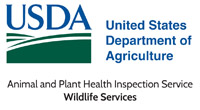United States Department of Agriculture: Animal and Plant Health Inspection Service

United States Department of Agriculture Wildlife Services: Staff Publications
Document Type
Article
Date of this Version
2000
Abstract
We evaluated a radar-activated integrated hazing system for the protection of waterfowl at large contaminated ponds at a power plant. The hazing devices in the system included acoustic alarm calls, pyrotechnics and chemical repellents dispersed in the form of a bird tear-gas. Unlike, timed interval systems, or systems with random activation sequences, birds did not habituate to the demand-performance system tested. Over the course of a year, we documented that waterfowl were 12.5 times less likely to fly over the hazed contaminated ponds relative to a non-hazed control pond. Of the waterfowl that did fly over both ponds, the likelihood of landing on the hazed contaminated pond was 4.2 times less relative to the control. Hazing also altered the flight direction and altitude of waterfowl. Mortality during the year the hazing system was in place decreased by a factor 6.5 relative to previous years where the system was not in operation. Demand-performance integrated hazing systems show promise in protecting large areas where placement of operators is not practical for logistic, safety, or long-term cost reasons.


Comments
Published in International Biodeterioration & Biodegradation 45 (2000) 129-137.